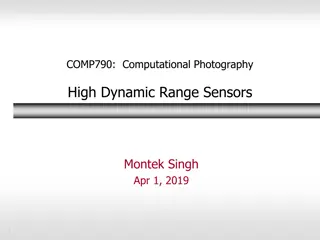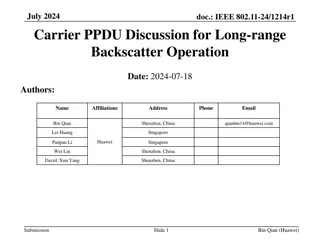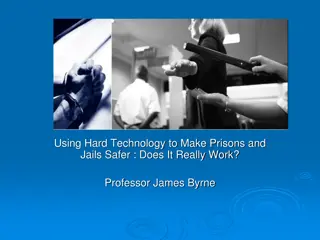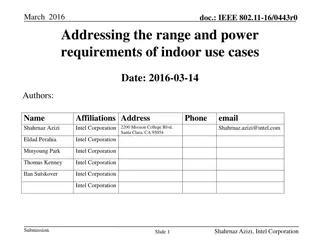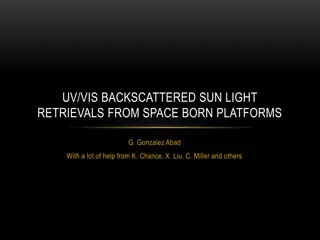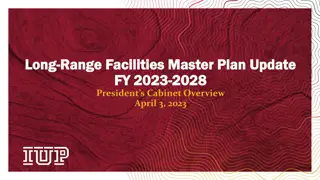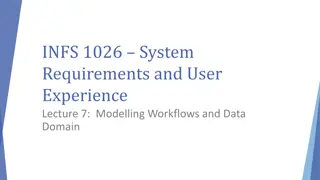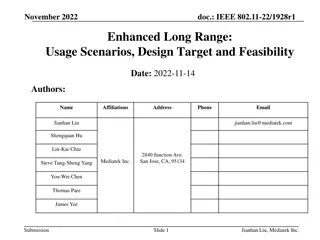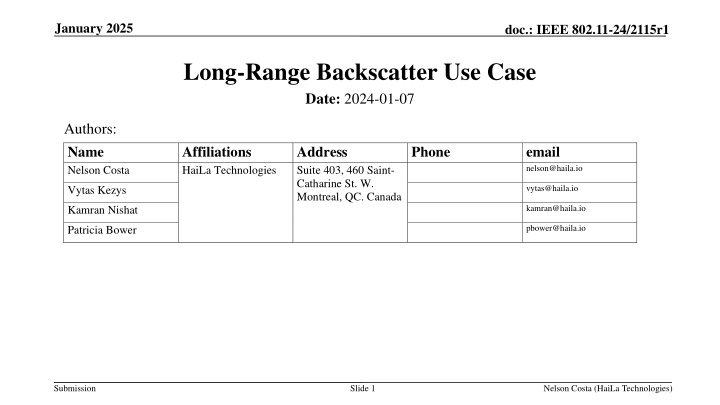
Long-Range Backscatter Use Case in IEEE 802.11
Explore the need to include features for long-range backscatter communication in the IEEE 802.11 standard. Current provisions focus on close-range backscatter, necessitating a distinct consideration for long-range applications. Various submissions highlight the evolving requirements and distinctions between mono-static and bi-static backscattering modes, emphasizing the significance of addressing implementation considerations for different ranges.
Download Presentation

Please find below an Image/Link to download the presentation.
The content on the website is provided AS IS for your information and personal use only. It may not be sold, licensed, or shared on other websites without obtaining consent from the author. If you encounter any issues during the download, it is possible that the publisher has removed the file from their server.
You are allowed to download the files provided on this website for personal or commercial use, subject to the condition that they are used lawfully. All files are the property of their respective owners.
The content on the website is provided AS IS for your information and personal use only. It may not be sold, licensed, or shared on other websites without obtaining consent from the author.
E N D
Presentation Transcript
January 2025 doc.: IEEE 802.11-24/2115r1 Long-Range Backscatter Use Case Date: 2024-01-07 Authors: Name Nelson Costa Affiliations HaiLa Technologies Address Suite 403, 460 Saint- Catharine St. W. Montreal, QC. Canada Phone email nelson@haila.io vytas@haila.io Vytas Kezys kamran@haila.io Kamran Nishat pbower@haila.io Patricia Bower Submission Slide 1 Nelson Costa (HaiLa Technologies)
January 2025 doc.: IEEE 802.11-24/2115r1 Abstract Make the case to create and include a subset of features that enable long- range backscatter in the SFD. Submission Slide 2 Nelson Costa (HaiLa Technologies)
January 2025 doc.: IEEE 802.11-24/2115r1 Background: Backscatter in Current SFD Draft Current SFD has some provisions for backscatter communications. Under 4.1 General, PM-3: 11bp defines at least one mode of MAC/PHY that supports close-range mono-static backscattering communication in 2.4 GHz. PM-4: 11bp defines at least one mode of MAC/PHY that supports bi-static backscattering communication in 2.4 GHz. The SFD is largely mute on a long-range backscatter use case. We believe the requirements for long-range backscatter are significantly different from close-range mono-static backscattering . We believe bi-static backscattering may not cover the requirements for long-range backscatter. We also believe that implementation considerations for bi-static versus mono-static may be separate from long-range versus short-range , Submission Slide 3 Nelson Costa (HaiLa Technologies)
January 2025 doc.: IEEE 802.11-24/2115r1 Background: Prior Submissions DCN Author Title Notes Advocates for battery-free Wi-Fi devices. Coverage up to 30 m indoor, 100 m outdoor. Some requirements (Smart Home application): Service life > 10 years Introduces new category, "close-range (~10 cm)" backscattering. This is primarily for Consumer applications. Applications page for "AMP Backscattering Applications", in a caption, mentions "Read range requirement: several meters" Future application (11bp?) states read range of 5 - 10 cm with a phone. Tags in these cases are powered by the reader, 0 dBm "sufficient to energize the tag" Dynamic range assumes 20 dB isolation from antennas alone. States 30-50 dB dynamic range total. Zhisong Zuo et al. Use Cases for AMP IoT Devices 11-22/0963 11-23/2038 Rui Cao et al.Close-range AMP Backscattering in 2.4GHz Technical Report on support of AMP IoT devices in WLAN 11-23/2203 everyone Everything's in here. Quoting 23/2203, three backscattering device classes considered: 1) without power storage, 2) with power storage, 3) with power storage and "tx LNA" Quoting [7] (BackCom), they consider two backscatter topologies 1) monostatic (MoBC), 2) bistatic (BiBC). Monostatic backscatter assumes 30 - 50 dB Tx/Rx isolation Asserts that bistatic backscatter won't need to consider Tx/Rx isolation. This is only true of an unmodulated carrier. MoBC: 2 - 2.8 m, BiBC: 0.8 - 1.3 m (downlink), 13.8 - 31.5 m (uplink) Tx waveform was indeterminate: stated 11b or OFDM could be used. Rx path involved: "Fixed" AGC Matched filter for increased SNR Differential decoding for interference mitigation Repetition combining OOK based detection Suggested 2x2 Wi-Fi devices already have a 1Tx + 1Rx mode, implying that regular Wi-Fi devices can do duplex comms. Largely a rehash of 11-24/537, but introduces effects of sloppy clocks on backscatter. Cite example from UHF RFID tags, FM0, and Miller Coding for timing recovery. Coex mechanism only via "Legacy preamble"; nothing else in the PPDU is decodable by legacy receivers. Claim 22 - 26 cm range, clock accuracy penalty of 6 - 15 cm for 100k PPM clock. For AMP IoT talks about 10 - 30 m ("RF Power") and up to 200 m "other ambient power". <1 mW consumption. Three scenarios, 1) short/med range (10-100 m), 2) "close" range (20 - 50 cm), 3) "Compatible Ambient IoT" (10 - 100 m). Backscatter with/without a reflection amplifier. Amp provides up to 15 dB gain @ 100 W. Backscatter without amp = approx. 2 m, with amp approx. 11 m. States "short/medium range" AMP device are required to have energy storage mechanism as can rely on WPT alone. Advocates for clock accuracy of 10k PPM at tag. Covers both "close range" and "long range" backscattering cases. Long range backscatter case shown as bi-static topology. "Close range" backscatter is from 11-23/2038 model. Long range "several meters", "Close range" 20 cm. Presented link margins for long range backscatter use case. The link margins don't appear to consider "self-jamming" 11-24/0075 Wei Lin et al.Follow Up on AMP Link Budgets Rui Cao et al.Close-range AMP WiFi Reader Feasibility Study 11-24/537 Close-range AMP WiFi Reader Feasibility Study Follow up 11-24/798 Rui Cao et al. Design target and device capabilities for AMP IoT 11-24/0853 W. Xu et al. 11-24/1215 Wei Lin et al.Feasibility study on long range backscatter operation Submission Slide 4 Nelson Costa (HaiLa Technologies)
January 2025 doc.: IEEE 802.11-24/2115r1 Background: Some take-aways Service ranges for backscatter-specific applications are divided between close range 10 50 cm, and long-range 2 32 m. Clock accuracy greatly affects range (no matter the application.) There are applications that consider a battery here, we consider a lifetime battery; a battery that does not require replacement over the lifetime of the product. Lifetime battery applications ease market adoption. Most backscatter applications did not consider self-jamming in their link budgets. With modulated carriers, self-jamming is the limiting factor in link budgets [2]. Submission Slide 5 Nelson Costa (HaiLa Technologies)
January 2025 doc.: IEEE 802.11-24/2115r1 Backscatter Trade-off Space We believe the parameters defining use case should be Mono- versus bi-static Short- versus long-range. Range is one of the biggest factors in determining application space. Submission Slide 6 Nelson Costa (HaiLa Technologies)
January 2025 doc.: IEEE 802.11-24/2115r1 Implementation Differentiators Submission Slide 7 Nelson Costa (HaiLa Technologies)
January 2025 doc.: IEEE 802.11-24/2115r1 Long Range Vs. Short Range: Other Trade-offs Feature Training sequence Long Range Training required by the receiver to be in the backscatter waveform. Coherent decode increases range. Long range requires better training sequences to mitigate channel and radio impairments. Emphasis on Range. Difference in energy expenditure on backscatter is minimal between different waveforms. Waveform generated at the Tx, not at the tag. BPSK gets us the longest range. Better backscatter efficiency gets us more range. 10-year battery useful as WPT coverage may be limited in larger areas. This also includes solar (PV cell) based applications. Clock accuracy may be higher because range becomes more important. Clock accuracy affects link margin. Short range Can use cancellation techniques in the monostatic case to reduce self-jamming. Uplink (backscattered) waveform Loss in range using OOK, Manchester encoded is acceptable. OOK also allows for energy capture during modulation (backscatter switches to a load instead of short/open). Battery versus WPT WPT coverage acceptable. Clock accuracy Loss in range due to clock inaccuracies is a percentage of total range; clock accuracy has less effect on absolute range than with longer range applications. Adoption, backward compatibility, feature reuse In-market Wi-Fi receivers provide receiver diversity, eases market adoption. Channel shifting provides for more range. Many existing waveforms are compatible with backscatter. Requires new infrastructure. Applications Longer ranges widen the application space. Shorter ranges restrict the application space. Cost Can be higher cost because of energy storage requirements. Typically, low cost, simpler design. Submission Slide 8 Nelson Costa (HaiLa Technologies)
January 2025 doc.: IEEE 802.11-24/2115r1 Conclusion The requirements for long-range backscatter are significantly different from that of close-range backscatter. Long-range bistatic backscatter can also be used with existing infrastructure. The long-range case overlaps with both monostatic and bistatic topologies. We propose to include a long-range backscattering use case in 11bp AMP. Submission Slide 9 Nelson Costa (HaiLa Technologies)
January 2025 doc.: IEEE 802.11-24/2115r1 Straw Polls SP1: Do you agree that 11bp should support optional features that enable backscatter communications at ranges beyond those considered for close range backscatter. Submission Slide 10 Nelson Costa (HaiLa Technologies)
January 2025 doc.: IEEE 802.11-24/2115r1 Straw Polls SP2: Do you agree to add the following content to TGbp SFD? 11bp defines a set of features that support long-range backscatter communication in 2.4 GHz. Submission Slide 11 Nelson Costa (HaiLa Technologies)
January 2025 doc.: IEEE 802.11-24/2115r1 References [1] Kezys, 802.11 Feature Re-use, 11-24/1210, July 2024. [2] Costa et al., Frequency Shifting in Backscatter Operations, 11-24/1687, November 2024. Submission Slide 12 Nelson Costa (HaiLa Technologies)

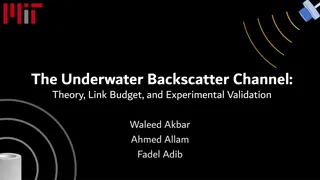
![Long-Range Wireless Charging Market Report & Analysis _ BIS Research [2024-2035]](/thumb/87166/long-range-wireless-charging-market-report-analysis-bis-research-2024-2035.jpg)

